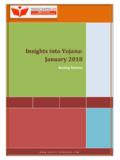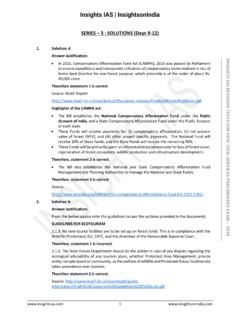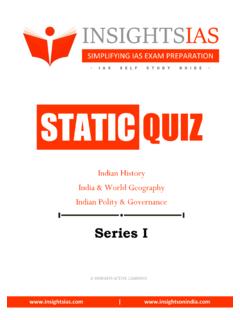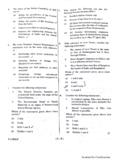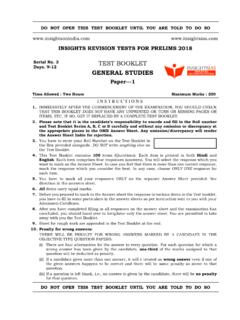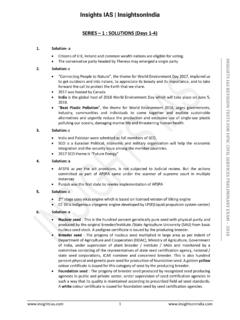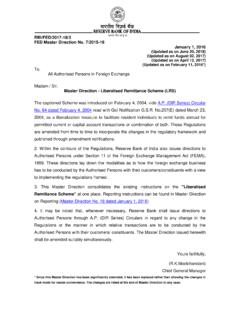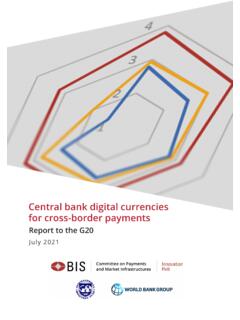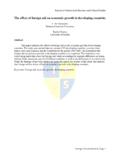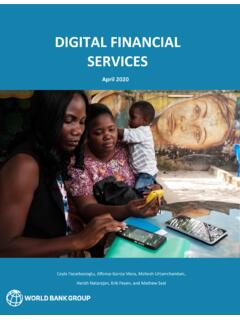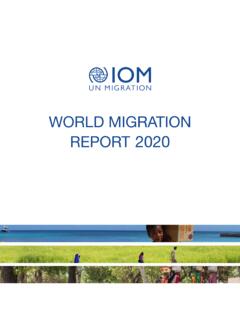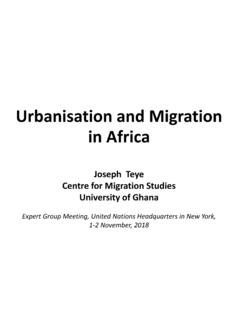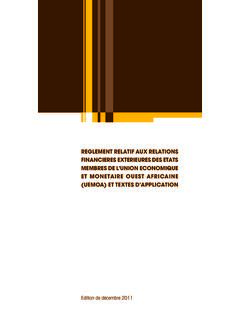Transcription of 12. International relations - INSIGHTSIAS
1 12. International relationsIndian Diaspora1. The Indian diaspora comprises approximately 31 millionpeople contributing both via remittances and knowledge transfers to theIndian economy. These factors make India s engagement with itsdiaspora important, which has evolved over the years. 2. Diaspora policy1. In the 1990s the advent of liberalization in India set the context forchanges in diaspora engagement. The Indian diaspora in countriessuch as the USA had achieved significant economic success andtechnical leadership in sectors such as IT. India was also lookingfor investments as well as knowledge transfer from this section. Inthe gulf the diaspora had become an important source ofremittances. The diaspora too was keen to maintain contacts withits cultural Diaspora engagement received further fillip with the introductionof the Pravasi Bhartiya Divas in 2003. Unique initiatives such asthe Person of Indian Origin (PIO) and Overseas Citizen of India(OCI) cards also date back to this Government s outreach: Recent MEA efforts via twitterdiplomacy, passport assistance, people-people ties, culturalengagements have further ensured there remains a thrivingconnect with the Merger of PIO and OCI categories: The merger of PIO and OCIcards has simplified procedural aspects of Diaspora s engagementwith home.
2 5. Rescue efforts: Operation Rahat in Yemen in 2015 was in linewith earlier such evacuation efforts in the Pravasi Kaushal Vikas Yojana (PKVY): A skill developmentprogram targeted at Indian youth seeking overseas employment tomake India the skill capital of the world. 7. Know your India programme (KIP): Youth-centric outreachprogrammes include Know India Programme (KIP). 8. Pravasi Bhartiya Kendra: On the occasion of Gandhi Jayanti in2018 the Overseas Indian Centre was launched in Labour issues being faced by the diaspora: Minimum wagereferral policy in the Gulf countries have impacted labour welfare,with people seeking rehabilitation and other welfare Engagement with Global talent: From Google CEO SundarPichai, to Microsoft s Satya Nadella, to Bollywood projects suchas Airlift the diaspora has been in the centre stage owing towhich the nature of the relationship between the government andpeople has Labour organisation (ILO)1.
3 It is the only tripartite United Nations agency - bringing togethergovernments, employers and workers representatives from its 187member states to devise International labour standards. It became thefirst specialized agency of UN in 1946. 2. Contribution of ILO1. Workers right: The ILO Declaration on Fundamental Principlesand Rights at Reducing forced labour and providing minimum wagescale: The organisation has set uniform, universal standards forcorporations to follow. 3. Employment: From advice to government policies to directtraining to poor Migrants: Protection of Migrant Reducing Child Labour: To eradicate child labour, the ILO hadlaunched International Programme on the Elimination of ChildLabour (IPEC) in HIV/AIDS: The ILO is the lead UN-agency on HIV workplacepolicies and programmes and private sector Failures of ILO4. To coincide with its 100th year, the ILO has announced a GlobalCampaign, Taking the ILO to the people , that demonstrates therelevance of the organisation s founding mandate to contemporarychallenges and its central role in helping build a fairer future for all.
4 Indian oceanEconomic importance1. First, it enjoys a privileged location at the crossroads of global trade,connecting the major engines of the International economy in theNorthern Atlantic and Asia-Pacific. This is particularly important in anera in which global shipping has burgeoned. 2. 2/3rd of India's oil imports enter into and out of the Indian Ocean,including the Straits of Malacca and Hormuz and the Bab-el-Mandeb3. The Ocean s vast drainage basin is important in its own right, home tosome two billion people. This creates opportunities, especially given thehigh rates of economic growth around the Indian Ocean The Indian Ocean is rich in natural resources. Forty per cent of theworld s offshore oil production takes place in the Indian Ocean Fishing in the Indian Ocean now accounts for almost 15 percent of theworld s total. Aquaculture in the region has also grown 12-fold since1980. 6. Mineral resources are equally important, with nodules containingnickel, cobalt, and iron, and massive sulphide deposits of manganese,copper, iron, zinc, silver, and gold present in sizeable quantities on thesea bed.
5 Additionally, various rare earth elements are present, even iftheir extraction is not always commercially feasible taken by India to improve maritime security1. Sagarmala project is being pursued, which aims to improve the portinfrastructure and connectivity. McKinsey report states that the projectcan add 4% of Joint military exercises like Indira (Russia), Malabar (US) have helpedIndia portray its navy s Project MAUSAM has been aimed at connecting IO region countrieson ancient, cultural India s Necklace of Diamond policy is aimed as a counter to China sString of Push for developing blue water navy by reaching out to IO Indian ocean s International Fleet Review (IFR) and heavy participationfrom various nations only shows the increasing importance that India isattaching to IO and its global to secure Indian ocean1. India should boost Andaman and Nicobar with resources to make it acentre for viable military outreach in IO region as well as in dominatingthe strategic sea-lanes and choke India should use its Geo-strategic advantage to become leader in IOregion by providing net security to IO region as recognised by IndianMaritime Security strategy Regional cooperation should be enhanced through forums likeBIMSTEC, SAARC, MILAN platform (navies from Indian ocean region) should be activelyencouraged to familiarise navies of littoral countries, cultural know-how.
6 5. Regional growth, prosperity and security in the Indian ocean regionshould be increased through MAUSAM, SAGAR. 6. Development of blue economy should be extended to Mauritius, SriLanka, Maldives. Africa1. India Africa relations date back to pre-independence era and werestrengthened during the independence movement of India. After India'sindependence India s non-alignment policy, anti-colonial, anti-raciststand brought India Africa even closer. Indian development initiatives in Africa1. Indian Technical and Economic Cooperation (ITEC) that aims atcapacity building, skill development, transfer of technology, etc. 2. Pan-African e-network: Launched in 2006, this is a joint effort ofIndia and African Union with an aim to provide satellite connectivity,tele-education and tele-medicine services to the African countries. 3. Cooperation with African Development Bank (AfDB): India joinedAfDB in 1983 and has contributed to its general capital and has alsopledged capital for grants and loans.
7 4. Solar Mamas: It is group of rural women solar engineers from Africawho have been trained under Government of India supportedprogramme to fabricate, install, use, repair and maintain solar lanternsand household solar lighting systems in their villages. 5. Development Assistance: India has announced a US$ 10 billion line ofcredit to help financing the projects in African countries, capacitybuilding, IT education, and higher education. Pacific islandsJapan1. Toward a Free, Open and Prosperous Indo-Pacific". Rules-basedorder in the Indo-Pacific region. 2. India-Japan $75 billion currency swap. 3. Comprehensive Economic Partnership Agreement (CEPA) signed in2011. 4. India s mega infrastructure projects like the Delhi-Mumbai FreightCorridor, Delhi- Mumbai Industrial Corridor, Chennai-BangaloreIndustrial Corridor and the Ahmedabad-Mumbai High Speed North East integration- India s Act east policy has North eastdevelopment at its Outside India- Asia-Africa Growth Corridor (AAGR) announced in2017 and joint projects in some third countries like Defence ties- Quadrilateral Security Dialogue is a strategic dialoguebetween India, United States, Japan and Australia will be carried Trilateral naval exercise called Exercise Malabar.
8 9. Conclusion: It is clear that the government has set India-Japan ties onan accelerated geopolitical course that will be a major factor in itsdealings with the rest of the world. China s one belt one road initiative1. Silk road initiative of China involves building infrastructure, setting upof industries and boosting people to people contacts in the regionsproposed in the silk road plan. The One Belt, One Road (OBOR)consists of Silk Road Economic Belt (SREB) and the Maritime SilkRoad (MSR).2. One Belt, mainly known as SREB, implies land corridor connectivityfrom China to Central Asia and West Asia, going all the way to Road, known as MSR, implies maritime connectivity through theStrait of Malacca to India, and onwards to West Asia and East Reasons why China is building it1. China s export and FDI driven economic model is losing itseffect. So China needs to find new export 80% of China s imports come from Strait of Malacca which ispirate infested.
9 So, China wants to secure this lane and avoid thisto large The growing disparity between Coastal China vs Inland China iscreating social problems, helping extremists and people becomingmore vocal. Hence China needs to develop those 12 Since 2011, because of South China Sea dispute, China s relationsbecame bitter with Cambodia, Laos, Thailand, Malaysia, Silk Road policy seems to be aimed at defusing tensions viasoft language and economic China want to counter USA s pivot to Asia policy, TPP and otherinterventions of US in South eastern Asia like in China wants to gain access to Bay of Bengal and Indian , need better relations with Myanmar and Reviving its ancient cultural Encircle India. Revisionist policy of China. 9. Strengthen China's Benefits to India1. The project will enhance India s connectivity with Central Asiawhich will increase trade and people to people movement and The proposed road, could bring in some serious investment in theotherwise poor and less invested eastern part and Northeasternpart of India, and thereby creating employment and Pakistan and China relations are on a high since the China-Pakistan economic corridor being launched.
10 India can retain thebalance of power in South The proposed route also is a hub for hydrocarbon trade. The routecould act as a bliss for transfer of oil and petroleum products fromnot only Gulf but also from Indonesia through the Straits India too through its Look-east policy (LEP) is trying to envisagea friendly neighbourhood with East Pacific countries. This cancreate such potential friendly The south Asia region is bustling with opportunities, anddissolving trade barriers and creating a favourable economicsituation is the need of the Challenges1. OBOR s flagship project is the China-Pakistan EconomicCorridor (CPEC), which runs through the Gilgit-Baltistan region,ignoring India s sovereignty and territorial integrity .2. India claims that China has never fully explained its plan for theBelt and Road initiative. There is a lack of transparency inChina s B&RI infrastructure project structure smacks of Chinese neo-colonialism.



